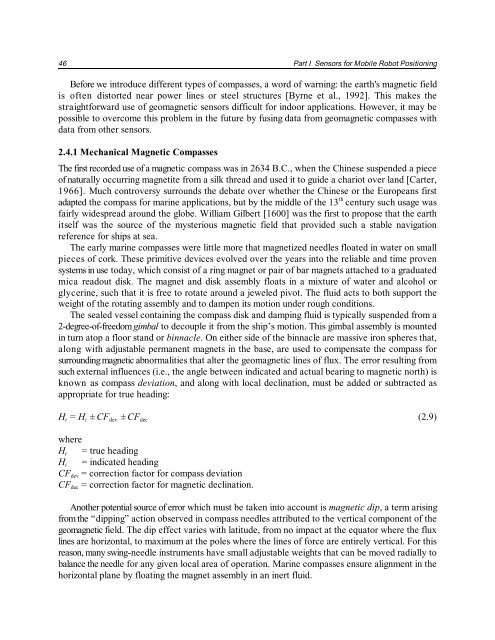Sensors and Methods for Mobile Robot Positioning
Sensors and Methods for Mobile Robot Positioning
Sensors and Methods for Mobile Robot Positioning
You also want an ePaper? Increase the reach of your titles
YUMPU automatically turns print PDFs into web optimized ePapers that Google loves.
46 Part I <strong>Sensors</strong> <strong>for</strong> <strong>Mobile</strong> <strong>Robot</strong> <strong>Positioning</strong><br />
Be<strong>for</strong>e we introduce different types of compasses, a word of warning: the earth's magnetic field<br />
is often distorted near power lines or steel structures [Byrne et al., 1992]. This makes the<br />
straight<strong>for</strong>ward use of geomagnetic sensors difficult <strong>for</strong> indoor applications. However, it may be<br />
possible to overcome this problem in the future by fusing data from geomagnetic compasses with<br />
data from other sensors.<br />
2.4.1 Mechanical Magnetic Compasses<br />
The first recorded use of a magnetic compass was in 2634 B.C., when the Chinese suspended a piece<br />
of naturally occurring magnetite from a silk thread <strong>and</strong> used it to guide a chariot over l<strong>and</strong> [Carter,<br />
1966]. Much controversy surrounds the debate over whether the Chinese or the Europeans first<br />
th<br />
adapted the compass <strong>for</strong> marine applications, but by the middle of the 13 century such usage was<br />
fairly widespread around the globe. William Gilbert [1600] was the first to propose that the earth<br />
itself was the source of the mysterious magnetic field that provided such a stable navigation<br />
reference <strong>for</strong> ships at sea.<br />
The early marine compasses were little more that magnetized needles floated in water on small<br />
pieces of cork. These primitive devices evolved over the years into the reliable <strong>and</strong> time proven<br />
systems in use today, which consist of a ring magnet or pair of bar magnets attached to a graduated<br />
mica readout disk. The magnet <strong>and</strong> disk assembly floats in a mixture of water <strong>and</strong> alcohol or<br />
glycerine, such that it is free to rotate around a jeweled pivot. The fluid acts to both support the<br />
weight of the rotating assembly <strong>and</strong> to dampen its motion under rough conditions.<br />
The sealed vessel containing the compass disk <strong>and</strong> damping fluid is typically suspended from a<br />
2-degree-of-freedom gimbal to decouple it from the ship’s motion. This gimbal assembly is mounted<br />
in turn atop a floor st<strong>and</strong> or binnacle. On either side of the binnacle are massive iron spheres that,<br />
along with adjustable permanent magnets in the base, are used to compensate the compass <strong>for</strong><br />
surrounding magnetic abnormalities that alter the geomagnetic lines of flux. The error resulting from<br />
such external influences (i.e., the angle between indicated <strong>and</strong> actual bearing to magnetic north) is<br />
known as compass deviation, <strong>and</strong> along with local declination, must be added or subtracted as<br />
appropriate <strong>for</strong> true heading:<br />
H = H ± CF ± CF (2.9)<br />
t i dev dec<br />
where<br />
H t = true heading<br />
H i = indicated heading<br />
CF dev = correction factor <strong>for</strong> compass deviation<br />
CF dec = correction factor <strong>for</strong> magnetic declination.<br />
Another potential source of error which must be taken into account is magnetic dip, a term arising<br />
from the “dipping” action observed in compass needles attributed to the vertical component of the<br />
geomagnetic field. The dip effect varies with latitude, from no impact at the equator where the flux<br />
lines are horizontal, to maximum at the poles where the lines of <strong>for</strong>ce are entirely vertical. For this<br />
reason, many swing-needle instruments have small adjustable weights that can be moved radially to<br />
balance the needle <strong>for</strong> any given local area of operation. Marine compasses ensure alignment in the<br />
horizontal plane by floating the magnet assembly in an inert fluid.

















